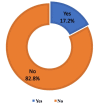Knowledge, Perception, and Associated Factors of Electronic Cigarette Consumption Among the Saudi Population in Jeddah City
- PMID: 38736764
- PMCID: PMC11088950
- DOI: 10.7759/cureus.60155
Knowledge, Perception, and Associated Factors of Electronic Cigarette Consumption Among the Saudi Population in Jeddah City
Abstract
Introduction Electronic cigarettes (e-cigarettes) are rising in popularity among young adults and teenagers. Previous studies have shown that among high and middle schoolers, the percentage of e-cigarette smokers was noticeably higher than tobacco cigarette smokers. Various research papers focusing on different communities have reported a low-to-moderate level of knowledge and awareness of e-cigarette's effects on health. E-cigarettes were initially advertised as devices to help people quit smoking, but the use of e-cigarettes in modern days has changed considerably. A big chunk of the population perceived that e-cigarettes have no harmful effects because they are nicotine-free and thus are used as a replacement for regular cigarettes rather than as a way to quit smoking. Objectives The study aimed to assess the perception of e-cigarette consumption and associated factors among the Saudi population in Jeddah city. Methodology A cross-sectional study was conducted on the Saudi population in Jeddah, Saudi Arabia, during the year 2023. The study assessed the participant's perceptions of e-cigarette consumption and its risk factors. A pre-existing online questionnaire created by Google Forms was distributed among the population through social media applications to collect data after obtaining their informed consent. Results A total of 515 participants were included in this study. Relatives and friends were the most common sources (54%) for information about e-cigarettes. Of the sample, 17.5% thought that e-cigarettes were safer than conventional cigarettes, 13.4% used e-cigarettes on a regular basis, and 65% had not smoked electronically before. Vaping pushed only 17.2% to try traditional tobacco cigarettes, and 25% stopped using traditional tobacco products after starting to smoke e-cigarettes. Gender, age group, and total family salary were the associated factors with the use of e-cigarettes. In addition, an association between the perception of e-smoking and its use was noticed, as well as a significant association between gender and withdrawal symptoms. Conclusion A minority of the participants perceived that e-cigarette smoking is safer than conventional methods of smoking. The majority did not practice e-smoking at all. Furthermore, results showed that relatives and friends were the most common sources of information. The findings from the correlation testing underscore several noteworthy associations within the studied population. Notably, gender, age, total family salary, and occupation exhibited statistically significant correlations with e-cigarette usage.
Keywords: electronic cigarettes; jeddah city; nicotine; saudi population; traditional cigarettes; volatile organic compounds.
Copyright © 2024, Qureshey et al.
Conflict of interest statement
The authors have declared that no competing interests exist.
Figures







Similar articles
-
Electronic cigarette among health science students in Saudi Arabia.Ann Thorac Med. 2019 Jan-Mar;14(1):56-62. doi: 10.4103/atm.ATM_76_18. Ann Thorac Med. 2019. PMID: 30745936 Free PMC article.
-
Prevalence of Gastroesophageal Reflux Disease (GERD) Among Electronic Cigarette-Smoking University Students in Jeddah, Saudi Arabia.Cureus. 2023 Mar 8;15(3):e35890. doi: 10.7759/cureus.35890. eCollection 2023 Mar. Cureus. 2023. PMID: 37033588 Free PMC article.
-
Knowledge and awareness of the health effects of electronic cigarette among college students.J Med Life. 2025 Mar;18(3):235-245. doi: 10.25122/jml-2025-0016. J Med Life. 2025. PMID: 40291943 Free PMC article.
-
Public Health Policies on E-Cigarettes.Curr Cardiol Rep. 2019 Aug 28;21(10):111. doi: 10.1007/s11886-019-1204-y. Curr Cardiol Rep. 2019. PMID: 31463564 Free PMC article. Review.
-
Epidemiology of Using Electronic Cigarettes in Saudi Arabia: A Systematic Review.Cureus. 2025 Mar 1;17(3):e79870. doi: 10.7759/cureus.79870. eCollection 2025 Mar. Cureus. 2025. PMID: 40166797 Free PMC article. Review.
References
-
- World Health Organization: Tobacco. World Health Organization: Tobacco. [ May; 2024 ]. 2021. https://www.who.int/news-room/fact-sheets/detail/tobacco) https://www.who.int/news-room/fact-sheets/detail/tobacco)
-
- Centers for Disease Control and Prevention. Smoking & Tobacco Use. [ May; 2024 ]. 2021. https://www.cdc.gov/tobacco/index.htm https://www.cdc.gov/tobacco/index.htm
-
- National Cancer Institute. Harms of Smoking and Health Benefits of Quitting. [ May; 2024 ]. 2021. https://www.cancer.gov/about-cancer/causes-prevention/risk/tobacco/quit-... https://www.cancer.gov/about-cancer/causes-prevention/risk/tobacco/quit-...
-
- The emerging phenomenon of electronic cigarettes. Caponnetto P, Campagna D, Papale G, Russo C, Polosa R. Expert Rev Respir Med. 2012;6:63–74. - PubMed
-
- Stratton K, Kwan LY, Eaton DL. Public Health Consequences of E-Cigarettes. Washington, DC: The National Academies Press; 2018. - PubMed
LinkOut - more resources
Full Text Sources
